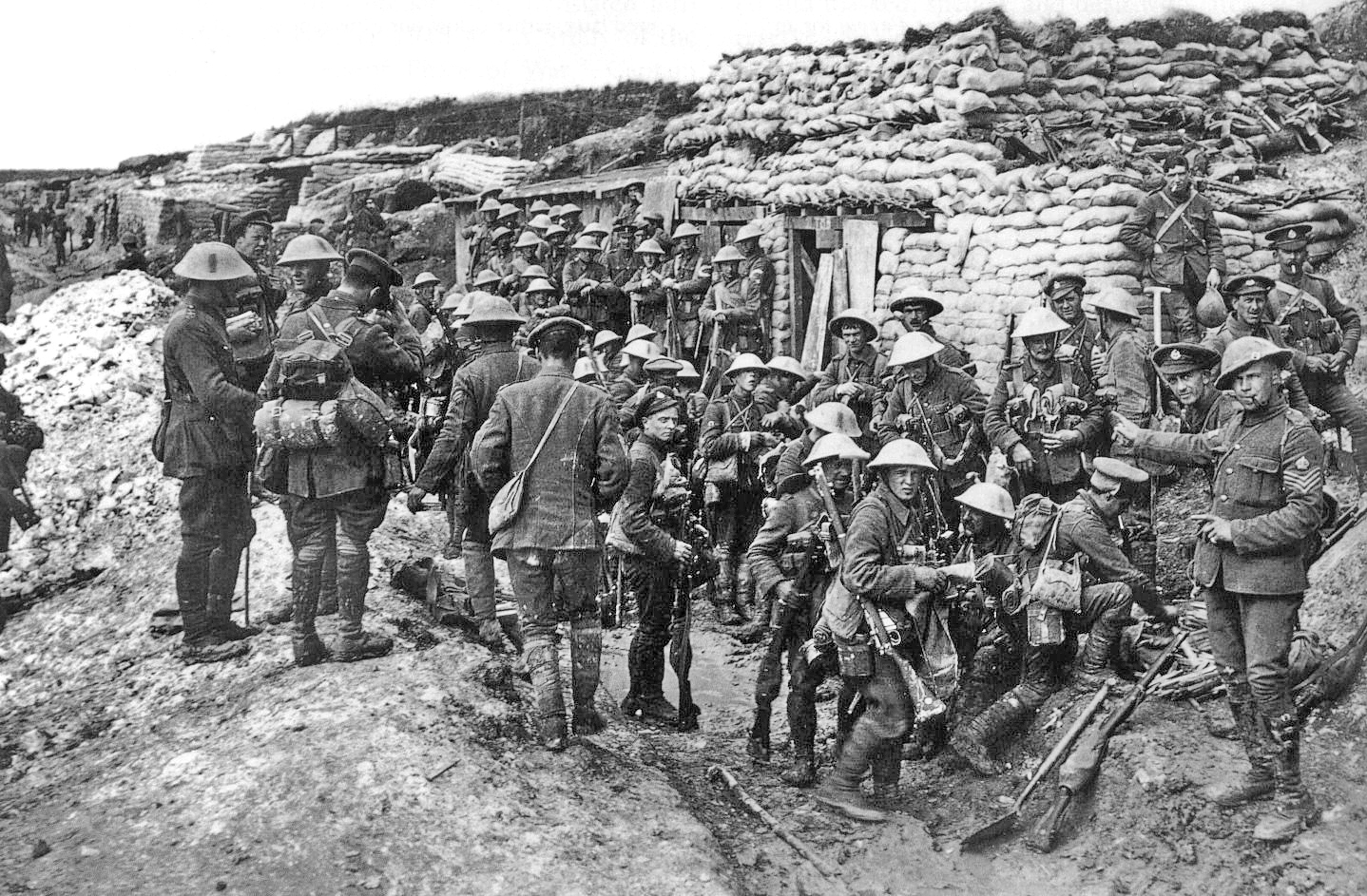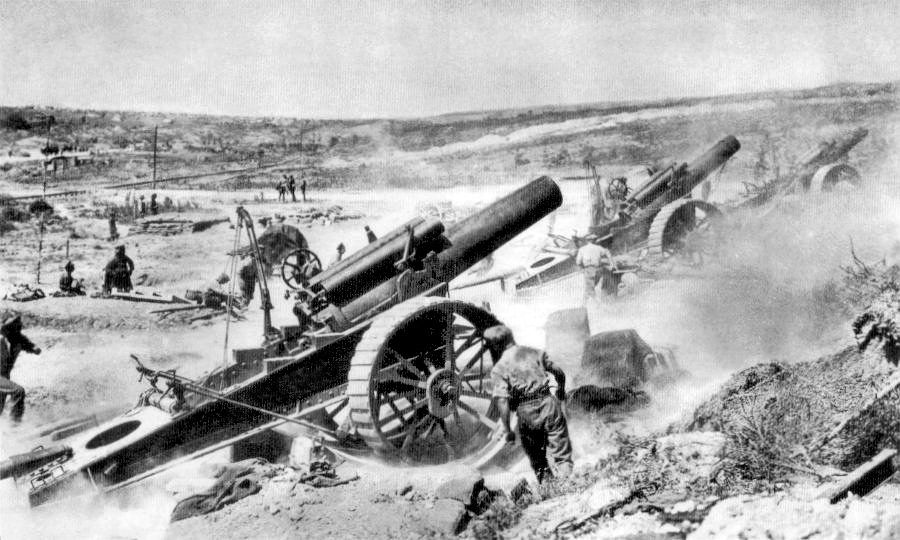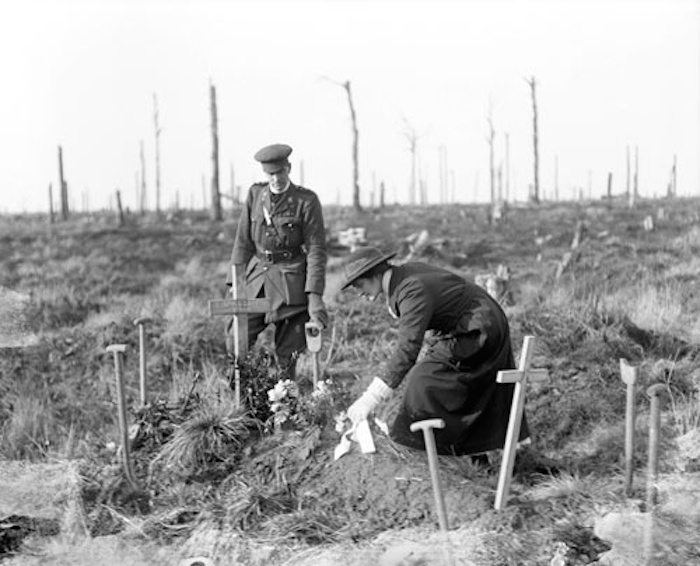Battle of the Somme July 1916

Group of soldiers preparing for the attack on Beaumont Hamel including the 16th Battalion Middlesex Regiment (to the right), 1st Bn East Lancashire Regiment and 2nd Bn Seaforth Highlanders (behind).
Image Q796 courtesy of IWM (photo by official photographer Lieutenant Ernest Brooks)
The Battle of the Somme was the British Army’s major offensive on the Western Front. July 1st 1916 is now known as the ‘Bloodiest Day of the British Army’. There were 57,470 British casualties on that day, of whom 19,240 died. Over the ensuing months, minor but effective gains and changing military tactics accompanied appalling losses. The British forces did advance alongside the French sixth army at the southern end of the line on the 1st and efforts were focused on this section thereafter. Fourth, Fifth and Third Army were present (13 British Divisions plus 11 French divisions on July 1st, 51 British Divisions plus 48 French Divisions July – November). The battle incorporated a series of attacks between July and November. Some were fairly localised while others were much wider in scope. The main battles in July included the first day, the Battle of Albert (July 1st – 13th), Battle of Bazentin Ridge (July 14th – 17th) and the Battle of Fromelles (19th – 20th July). The battles of Delville Wood and Pozières began in July and continued into the summer.
July 1st, 1916
Following the artillery bombardment of German positions at the end of June, the first day of the Battle of the Somme began with a storm of shells and huge mine explosions. At 7.30 a.m the British infantry began their steady advance across No Man’s Land where they were mown down by machine gun and rifle fire, suffering unprecedented casualties. A barrage of enemy artillery fire in front of their trenches added to the confusion. Among the thousands killed were two men from Radcliffe on Trent.
July 1st 1916, 1st day of the Battle of the Somme. Death of 2nd Lt. Robert Blatherwick, 10th Bn. West Yorkshire Regiment (Prince of Wales’s Own), 62nd Brigade, 21st Division, XV Corps. Killed in action near Fricourt village, 5 km east of Albert. Age 21. He was a trainee architect from Radcliffe and brother of George, who died at Gallipoli. The 10th W. Yorks. suffered the heaviest losses of any battalion that day. Estimates vary between 710 and 750 men.
From West Yorkshire Regimental War Diaries:
At 7.30 a.m. the Battn took part in the grand assault. The objective being as in the attached orders. (no attachment is available). On the right were the 7th Divn. and on the left were the 21st Divn. The Battn assaulted in 4 lines. 2 lines got through the German position to the 4th line, & were cut off, the attack on our left having failed. Casualties were very heavy, chiefly caused by machine guns which enfiladed our left flanks & were so deadly that the third & 4th lines failed to get across “no man’s” land. 22 officer casualties including Lt Col Dixon commanding & Major J Knott 2nd in command. Both killed and approximately 750 O.R. (other ranks). The Battn was then withdrawn to VIlle.
July 1st 1916, 1st day of the Battle of the Somme. Death of Private 12/967 Cecil Ingram, 12th Bn. Yorks. and Lancaster Regiment, 94th Brigade, 31st Division, VIII Corps. Killed in action on the Somme in the vicinity of Mark Copse and Roland Trench. Age 27, an electrician from Radcliffe working in Sheffield before the war.
From Yorks and Lancs Regimental War Diaries:
A great many casualties were caused by the enemy’s machine guns; in fact the third and fourth waves suffered so heavily that by the time they had reached No Man’s Land they had lost at least half their strength. Whole sections had been wiped out.
The 12th Yorks and Lancs moved up from Bois de Warnimont (30/6) and took up assembly positions for attack on Serre (1/7) – going forward on left of 94th Brigade’s attack most of the Battalion would be pinned down in No Man’s Land. A few men reached German line and some later entered Serre itself. Official History of The Great War notes that bodies of men from 12th Yorks and Lancaster were found in the north-west corner of the village during attack of (13/11). Withdrew after dark to Roland Trench. Source: Westlake, Ray (2009) Tracing British Battalions on the Somme (Barnsley: Pen & Sword)
July 1st, 1916. A diversionary attack by the 46th (North Midland) Division at Gommecourt, which was near the northern end of the line, resulted in the capture of Lieutenant John Fillingham Bishop, 1/7th Sherwood Foresters, from Radcliffe on Trent. He was wounded by a grenade in the right shoulder and both legs that day. He remained a prisoner in Germany until the armistice.
46th North Midland Division, VII Corps: The men were exhausted after ten days of digging asembly trenches. 1/7th and 1/5th Sherwood Foresters and 1/6th South Staffords and 1/6th North Staffords advanced through the smoke screen, the only time one was used on 1 July. But it had not gone far enough and they emerged from it in front of the wire. Only a few reached the enemy trenches.
Source, Rawson, Andrew (2016, p. 13) Ancestor’s Footsteps. The Somme 1916 (Barnsley: Pen and Sword)

39th Siege Battery, Royal Artillery on the Somme
Image Q5817 courtesy of IWM (photo taken by official British photographer Lieutenant John Warwick Brooke).
Battle of Albert
July 1st – 13th
Despite the overwhelming casualties on the first day, orders were given to continue the fighting on July 2nd. The Battle of Albert was characterised by slow and costly attacks with attempts to secure Contalmaison, Mametz Wood and Trones Wood, which were eventually captured. Three more Radcliffe men died in this period and another became terminally ill.
July 7th 1916, Mametz. Death of Corporal 188365 George Nowell, 10th Bn. Sherwood Foresters, 51st Brigade, 17th (Northern) Division, XV Corps. He had been a printer’s assistant in Radcliffe. Killed in action between Contalmaison and Mametz, age 24, during the attack at Quadrangle Support. There were heavy casualties that day in the battalion.
From Sherwood Foresters Regimental War Diaries (held at Regimental Museum, Nottingham):
At 6.45 p.m. orders were received to attack Quadrangle Support at 8 p.m. after 30 minutes bombardment. An attack on Contalmaison was also to be delivered by 3rd Corps on the left at the same time. This latter attack was not launched.
The time allowed for the organisation of the attack was not sufficient and consequently the necessary advantage could not be taken of the bombardment, and the attack was ragged. The attack was launched but Machine Gun Fire from both flanks, rifle and Machine Gun Fire from the objective and an enemy barrage prevented the troops from advancing over the heavy ground, and a withdrawal was ordered, and carried out in excellent style. The men were wet through and cold, the ground was heavy and both flanks were in the air.
At about 9 p.m. orders were received that the 7th Border Regt. were to relieve the battalion and on relief the battalion to proceed to area Willow Trench and Red Cottage.
This relief was a difficult matter and it was still not till 2 a.m. that the relief was complete. A, C and D Coys. took up positions near Fricourt Trench and B Coy. in Lonely Trench Bn. H.Q. under the crucifix at F.3.c.central. 3 a.m. Rations, including an issue of Rum, were fortunately available and the troops were enabled to have a meal and sleep.
How Radcliffe servicemen died
Radcliffe Servicemen and British Army
1914 Retreat from Mons
1914 Battle of the Marne, 1st Battle of Ypres
1915 Battle of Neuve Chapelle, Aubers Ridge
1915 Gallipoli
1915 2nd Battle of Ypres and other conflicts
1916 Conflicts prior to the Somme
1916 Battle of the Somme July
1916 Battle of the Somme August
1916 Battle of the Somme Autumn
1917 Battle of Arras
1917 3rd Battle of Ypres
1917 3rd Battle of Ypres (Passchendaele)
1918 German Spring Offensive
1918 3rd Battle of the Aisne
1918 HMS Leasowe Castle torpedoed
1918 Last 100 Days, 5th Battle of Ypres
1918 Final Days
1918 The Armistice

A white South African nurse placing a wreath on her brother’s grave at Delville Wood in February 1918. It was here that the South African Brigade suffered huge losses July-August 1916. Black South African unarmed combatants and non military personnel killed at Delville Wood were buried in civilian graves elsewhere due to the segregationalist policy of the South African government. During the Somme centenary, July 2016, President Jacob Zuma inaugurated a new memorial at Delville Wood honouring South Africans of all races who fought in the First and Second World Wars.
Image no. 10677 by official photographer 2nd Lt. T. K. Aitken, courtesy of Imperial War Museum
Mametz Wood
July 7th – 12th
An attack on Mametz Wood was largely carried out by the 38th (Welsh) Division with the objective of overcoming German positions. The assault was difficult and involved hand to hand combat once the isolated wood was reached. It was finally captured after brutal fighting and at a cost of around 4000 Welsh casualties. The 21st Division was brought in to assist on July 11th and included L/Sergeant 14988 Leonard Rushmore, 13th Bn, Northumberland Fusiliers, XV Corps, from Radcliffe on Trent. He had been gassed at the beginning of May and was shipped back to England with ‘shell shock’ immediately after Mametz Wood. He died at home in 1919, age 25.
Battle of Trones Wood
July 8th – 14th
Trones Wood was taken on July 14th, having been devastated after stiff combat. It is probably the site of the death of a Radcliffe on Trent artillery man.
July 14th 1916, Bronfay Farm. Death of Gunner 23394, George Brewster, 12th Siege Battery, Royal Garrison Artillery (Corps unknown). a regular soldier from The Harlequin, Radcliffe on Trent. Killed in action near Bronfay Farm, S.E. of Albert, Bray-Sur Somme. Age 30. The XIV Corps main dressing station was at the farm. It is not clear if George Brewster died at the dressing station or in the field.
Attack between Maltz Horn Farm and Arrow Head Copse
July 20th
Fighting continued in the Trones Wood area around Maltz Horn Farm and Arrow Head Copse after the wood itself was captured. A young junior officer from Radcliffe lost his life in the combat.
July 20th 1916, Trones Wood area. Death of 2nd Lt Robert Hallam, 15th Bn. Sherwood Foresters, 51st brigade, 35th Division, XIII Corps. He was a solicitor’s son from Chestnut Grove, Radcliffe. Missing in action during attack on positions between Maltz Horn Farm and Arrow Head Copse, south of Guillemont. Age 17. See below for two accounts of the conflict in which he died.
15th (Service) Battalion, The Sherwood Foresters, July 2016: Entrained at Chocques for Bouquemaison (3/7) and from there marched to Sus-St Leger. To Beauval (7/7), Bus – lès – Artois (10/7), Warloy (11/7), Heilly (12/7), Grove Town Camp (13/7), Billon Wood (14/7). Relieved 6th Northamptonshires in trenches south-east of Trones Wood (16/7). Attack on positons between Maltz Horn Farm and Arrow Head Copse (20/7). Withdrew at night and to Talus Boisé.
Source: Westlake, Ray (2009) Tracing British Battalions on the Somme (Barnsley: Pen & Sword)
On July 20th: Zero hour was 5 a.m. and the batteries fired blindly into the thick mist for thirty minutes. Gas shells incapacitated half the 15th Sherwoods and the sun had risen by the time the rest advanced from Trones Wood. They could not capture the trenches south of Arrow Head Copse or Maltz Horn Farm.
Source: Rawson, Andrew (2016, p.71) Ancestor’s Footsteps. The Somme 1916 (Barnsley: Pen and Sword).
